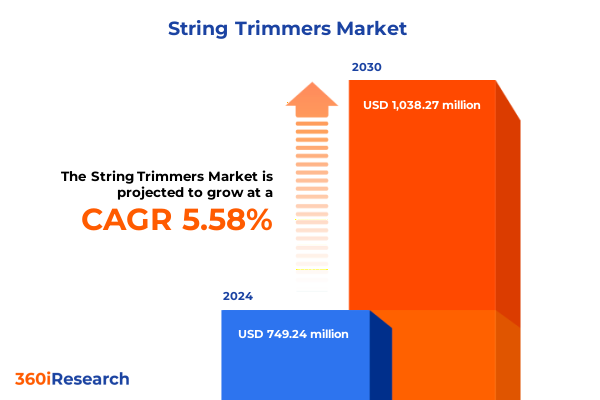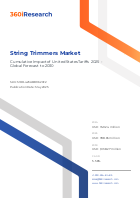The String Trimmers Market size was estimated at USD 749.24 million in 2024 and expected to reach USD 788.65 million in 2025, at a CAGR 5.58% to reach USD 1,038.27 million by 2030.

Introduction to the Evolving String Trimmers Market
The string trimmers market has evolved into a dynamic sector driven by technological innovation, environmental considerations, and shifting consumer preferences. As homeowners and professionals alike seek efficient and user-friendly landscaping tools, demand has accelerated for products offering enhanced performance, lower emissions, and simplified operation. This executive summary introduces the current state of string trimmers, highlighting the factors reshaping product development, distribution strategies, and customer adoption. It provides an expert overview of the critical forces at play, from the surge in battery-powered solutions to the influence of global trade policies, offering decision-makers a concise yet thorough understanding of how the market is transforming. Readers will gain insight into the key shifts defining competition, segmentation nuances, regional dynamics, and leading corporate strategies. By setting the stage here, this summary equips industry stakeholders with the essential context needed to navigate the complex landscape, identify emerging opportunities, and plan for sustainable growth in a market characterized by rapid technological progress and evolving regulatory frameworks.
Transformative Shifts Reshaping the Landscape
Over recent years, the string trimmers landscape has undergone transformative shifts that are redefining competitive advantage. Most notably, the transition from traditional gasoline engines to advanced battery platforms has accelerated, driven by improvements in battery life, power density, and charging infrastructure. Simultaneously, manufacturers have prioritized eco-friendly designs, spurred by tightening emissions regulations and consumer demand for quieter, zero-emission equipment. Digital integration is another groundbreaking trend, with connectivity features such as smartphone apps for performance monitoring and firmware updates enhancing the user experience. Safety innovations, including automatic line-feed mechanisms and intelligent posture-sensing systems, are also becoming standard. Meanwhile, supply chain resilience initiatives have gained prominence as companies diversify sourcing to mitigate tariff impacts and logistical disruptions. These cumulative changes are fostering new product categories, reshaping go-to-market approaches, and elevating customer expectations. Consequently, industry players are forging strategic alliances, increasing R&D investments, and exploring novel distribution channels to capitalize on these transformative trends.
Cumulative Impact of United States Tariffs in 2025
The introduction of United States tariffs in 2025 has had a multifaceted impact on the string trimmers industry, compelling companies to recalibrate pricing strategies, sourcing decisions, and partnerships. Import levies on key components such as brushless motors, battery cells, and specialized plastics have driven up production costs, prompting many manufacturers to explore alternative suppliers in tariff-free zones or invest in local assembly operations to preserve margin. In addition, some firms have renegotiated long-term contracts to incorporate tariff escalation clauses, ensuring greater cost predictability and supply continuity. While end-user pricing has marginally increased, proactive cost containment measures-such as lean manufacturing and component standardization-have mitigated significant market disruption. Moreover, these tariffs have accelerated vertical integration efforts, with leading players acquiring upstream partners to secure critical inputs. Despite initial concerns about demand contraction, overall market momentum has remained robust, buoyed by strong adoption of cordless systems and resilient outdoor maintenance trends among residential and commercial segments.
Key Segmentation Insights
Detailed segmentation provides actionable insights into how different product categories and end markets are performing, guiding strategic investments and product prioritization. Based on power source, string trimmers split into battery-powered machines, which include corded electric and cordless electric variants, and gasoline models that feature two-stroke and four-stroke engines. Each power option addresses specific user needs: corded designs offer continuous operation for large properties, while cordless systems enable portability and reduced maintenance, and gasoline offerings maintain traction in heavy-duty applications. Blade material variation, spanning metal blades prized for durability to lightweight plastic blades for user safety and affordability, further refines product positioning. Cutting width segmentation classifies tools into extra wide models for expansive commercial landscapes, medium widths that balance reach and control, and narrow heads suited for intricate residential edging. Shaft configurations vary between split-shaft units that facilitate multi-tool ecosystems and straight-shaft builds that deliver direct power transmission. Applications range from agricultural land management to municipal maintenance, commercial landscaping, and residential lawn care. End-user categories encompass do-it-yourself homeowners seeking cost-effective convenience, professional landscapers demanding high performance, and rental service providers requiring robust, easy-to-maintain equipment. Finally, distribution channel insights reveal that offline sales through garden equipment dealerships and supermarkets complement rapidly growing online sales via brand-owned websites and e-commerce marketplaces, underscoring the need for omnichannel strategies.
This comprehensive research report categorizes the String Trimmers market into clearly defined segments, providing a detailed analysis of emerging trends and precise revenue forecasts to support strategic decision-making.
- Power Source
- Blade Material
- Cutting Width
- Shaft Type
- Application
- End-user
- Distribution Channel
Key Regional Insights
Regional dynamics play a pivotal role in shaping market demand, with each geographic zone exhibiting distinct growth drivers and challenges. In the Americas, robust home-improvement spending and favorable financing options have propelled uptake of battery-powered trimmers, while professional landscaping services continue to drive sales of high-performance gasoline units. Supply chain localization efforts in North America have further bolstered domestic assembly. Across Europe, Middle East & Africa, stringent emissions standards and noise regulations have accelerated the transition to electrified models, with European Union directives guiding research into sustainable materials and end-of-life recycling programs. In the Middle East and Africa, expanding urban green spaces and government infrastructure projects offer growth opportunities for commercial-grade products. Meanwhile, the Asia-Pacific region demonstrates strong adoption of gasoline engines in emerging markets due to lower energy costs, even as advanced economies such as Japan and Australia shift decisively toward cordless solutions. Staple factors in Asia-Pacific include a vast agricultural segment in India and Southeast Asia, the proliferation of rental service models in urban centers, and the growing influence of leading domestic manufacturers leveraging cost advantages.
This comprehensive research report examines key regions that drive the evolution of the String Trimmers market, offering deep insights into regional trends, growth factors, and industry developments that are influencing market performance.
- Americas
- Asia-Pacific
- Europe, Middle East & Africa
Key Company Strategies and Market Positions
Leading manufacturers and distributors are adopting diverse strategies to capture market share and foster innovation. Ace Hardware Corporation leverages its widespread retail footprint to drive do-it-yourself adoption, while Agrotis Technologies LLP focuses on localizing production in Asia-Pacific to serve agricultural clients. Amalgamated Hardware Merchants Ltd. supports small-town dealerships with tailored sales programs. American Honda Motor Co., Inc. and Andreas STIHL India invest heavily in engine efficiency and emission-reduction technologies. Blackmax Tools Limited and Cramer differentiate through low-cost, high-durability gasoline models, while ECHO Incorporated pioneers ergonomic design for professional landscapers. Battery-specialist brands such as EGO POWER, Greenworks North America LLC and WORX emphasize rapid-charge systems and intelligent battery management. Major European players like Bosch Power Tools GmbH, Einhell Germany AG, Husqvarna AB, Kärcher and Stiga S.p.A. integrate digital services into their cordless portfolios. MacAllister Machinery, Makita U.S.A., Inc., Milwaukee Electric Tool Corporation and The Toro Company capitalize on maintenance connectivity and workflow integration. Positec Group Ltd., Ryobi Limited and Stanley Black & Decker, Inc. focus on ecosystem compatibility with modular tool systems. VEVOR and Zhejiang Zomax Garden Machinery Co.,Ltd. target budget-conscious segments with Chinese-manufactured options. Chhibber Agri. Equipments and Cramer serve niche agricultural and rural markets where reliable performance and serviceability are paramount.
This comprehensive research report delivers an in-depth overview of the principal market players in the String Trimmers market, evaluating their market share, strategic initiatives, and competitive positioning to illuminate the factors shaping the competitive landscape.
- Ace Hardware Corporation
- Agrotis Technologies LLP
- Amalgamated Hardware Merchants Ltd.
- American Honda Motor Co., Inc.
- Andreas STIHL India
- Blackmax Tools Limited
- Bosch Power Tools GmbH
- Chhibber Agri. Equipments
- Cramer
- ECHO Incorporated
- EGO POWER
- Einhell Germany AG
- Greenworks North America LLC
- Husqvarna AB
- Kärcher
- MacAllister Machinery
- Makita U.S.A., Inc.
- Milwaukee Electric Tool Corporation
- Positec Group Ltd.
- Ryobi Limited
- Stanley Black & Decker, Inc.
- Stiga S.p.A.
- The Toro Company
- VEVOR
- WORX
- Zhejiang Zomax Garden Machinery Co.,Ltd.
Actionable Recommendations for Industry Leaders
To thrive amid intensifying competition and evolving customer expectations, industry leaders should prioritize strategic initiatives that deliver differentiation and value. Companies need to accelerate development of high-performance battery platforms, investing in advanced cell chemistries, thermal management and rapid-charging infrastructure to address range anxiety and downtime concerns. They should also build supply chain resilience by diversifying component suppliers, strategically relocating assembly closer to key markets, and negotiating long-term agreements with tariff-flexible clauses. Collaboration with third-party software providers can enhance connectivity features, enabling predictive maintenance and usage analytics that lock in professional and rental customers. Moreover, expanding omnichannel distribution capabilities-including augmented reality tools in e-commerce channels and experiential retail activations in garden equipment dealerships-can deepen customer engagement and capture shifting buying preferences. Brands should emphasize sustainability through recyclable materials and end-of-life programs, aligning with regulatory pressures and consumer values. Finally, professional training and certification programs for landscapers and rental providers will reinforce brand loyalty, support premium pricing, and drive repeat business.
Explore AI-driven insights for the String Trimmers market with ResearchAI on our online platform, providing deeper, data-backed market analysis.
Ask ResearchAI anything
World's First Innovative Al for Market Research
Conclusion and Market Outlook
In summary, the string trimmers market stands at a pivotal juncture defined by advanced battery technologies, regulatory imperatives, and evolving customer behaviors. Segmentation analysis reveals clear opportunities across multiple power sources, blade configurations, applications and distribution channels. Regional dynamics underscore the need for tailored approaches in the Americas, Europe, Middle East & Africa, and Asia-Pacific. Tariff measures have prompted supply chain innovation, while competitive intensity has spurred R&D and digital integration. Leading companies are differentiating through specialized engines, ergonomic designs, connectivity solutions and omnichannel reach. By adopting the recommended strategies and leveraging these insights, stakeholders can navigate uncertainties, capture emerging growth pockets and secure long-term market leadership.
This section provides a structured overview of the report, outlining key chapters and topics covered for easy reference in our String Trimmers market comprehensive research report.
- Preface
- Research Methodology
- Executive Summary
- Market Overview
- Market Dynamics
- Market Insights
- Cumulative Impact of United States Tariffs 2025
- String Trimmers Market, by Power Source
- String Trimmers Market, by Blade Material
- String Trimmers Market, by Cutting Width
- String Trimmers Market, by Shaft Type
- String Trimmers Market, by Application
- String Trimmers Market, by End-user
- String Trimmers Market, by Distribution Channel
- Americas String Trimmers Market
- Asia-Pacific String Trimmers Market
- Europe, Middle East & Africa String Trimmers Market
- Competitive Landscape
- ResearchAI
- ResearchStatistics
- ResearchContacts
- ResearchArticles
- Appendix
- List of Figures [Total: 30]
- List of Tables [Total: 499 ]
Contact Ketan Rohom for Detailed Market Research Report
To acquire the full market research report and gain deeper insights, please contact Ketan Rohom (Associate Director, Sales & Marketing) to discuss how this analysis can inform your growth strategy and competitive planning.

- How big is the String Trimmers Market?
- What is the String Trimmers Market growth?
- When do I get the report?
- In what format does this report get delivered to me?
- How long has 360iResearch been around?
- What if I have a question about your reports?
- Can I share this report with my team?
- Can I use your research in my presentation?




